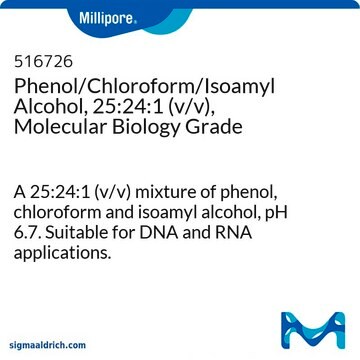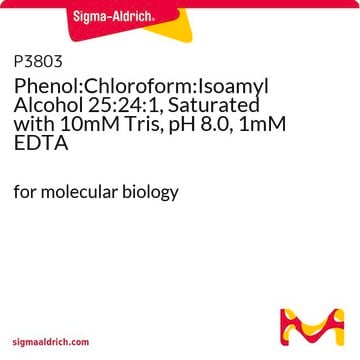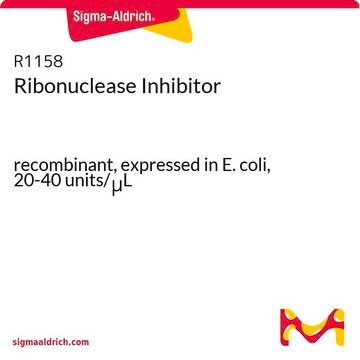10786357001
Roche
Ribonuclease H (RNase H)
from Escherichia coli H 560 pol A1
Synonym(s):
rnase h
Sign Into View Organizational & Contract Pricing
Select a Size
All Photos(1)
Select a Size
Change View
About This Item
UNSPSC Code:
12352204
Recommended Products
biological source
Escherichia coli ( H 560 pol A1)
Quality Level
assay
100%
form
solution
specific activity
~40000 units/mg protein
packaging
pkg of 100 U
manufacturer/tradename
Roche
technique(s)
cDNA synthesis: suitable
color
colorless
optimum pH
7.5-9.1
General description
Nonspecific endoribonuclease that specifically cleaves RNA in RNA:DNA hybrids. A minimum of four continuous base pairs (RNA:DNA) is required for activity. RNase H cleaves RNA to release 5′-oligoribonucleotides.
Source: E. coli H560 pol A1
Storage Buffer: 25 mM Tris-HCl, 50 mM KCl, 1 mM dithiothreitol, 0.1 mM EDTA, 50% glycerol (v/v), pH 8.0 (+4°C)
Volume Activity: 1 x 103 U/ml assayed according to Hillenbrand & Staudenbauer.
Source: E. coli H560 pol A1
Storage Buffer: 25 mM Tris-HCl, 50 mM KCl, 1 mM dithiothreitol, 0.1 mM EDTA, 50% glycerol (v/v), pH 8.0 (+4°C)
Volume Activity: 1 x 103 U/ml assayed according to Hillenbrand & Staudenbauer.
Ribonuclease H (RNase H) is a nonspecific endoribonuclease, localized to the nucleus and cytoplasm. It is ubiquitously found and widely present among many organisms including viruses and human.
Application
Ribonuclease H (RNase H) has been used for:
- In vivo RNA-primed initiation of DNA synthesis
- Elimination of mRNA during second-strand cDNA synthesis
- Site-specific cleavage of RNA
- Detection of RNA:DNA regions in double-stranded DNA of natural origin
- Removal of poly (A) sequences of mRNA if oligo (dT) is present
- RNA extraction and quantitative reverse transcriptase polymerase chain reaction (RT-PCR)
Biochem/physiol Actions
Ribonuclease H (RNase H) specifically cleaves RNA in RNA:DNA hybrids. A minimum of four continuous base pairs (RNA:DNA) is required for activity. RNase H cleaves RNA to release 5′-oligoribonucleotides. RNase H is associated with nucleic acid immunity. Using RNase H for degrading mRNA results in 80% depletion of mRNA and protein expression. RNase H recognizes the start codon and the 3′ and 5′ untranslated regions. This enzyme participates in DNA replication.
Features and Benefits
- Eliminate potential sources of PCR errors.
- Increase accessibility of primers during subsequent PCR.
Quality
Absence of endonucleases, nicking activities, and ribonucleases.
Unit Definition
RNase H is assayed according to Hillenbrand and Staudenbauer. One unit of RNase H is the amount of enzyme which produces 1 nmol acid-soluble ribonucleotides from[3H] poly(A) x poly(dT) in 20 minutes at +37 °C under the stated assay conditions.
Volume Activity: Approximately 1 U/μl
Volume Activity: Approximately 1 U/μl
Preparation Note
Activator: The enzyme has its maximal activity in presence of SH-reagents
Storage and Stability
Store at -15–-25 °C. (unopened)
Other Notes
For life science research only. Not for use in diagnostic procedures. Using RNase H after the cDNA synthesis step can increase the sensitivity of a two-step RT-PCR assay.
Storage Class
12 - Non Combustible Liquids
wgk_germany
WGK 1
flash_point_f
does not flash
flash_point_c
does not flash
Choose from one of the most recent versions:
Already Own This Product?
Find documentation for the products that you have recently purchased in the Document Library.
Customers Also Viewed
Amandine Bonnet et al.
Molecular cell, 67(4), 608-621 (2017-08-02)
Transcription is a source of genetic instability that can notably result from the formation of genotoxic DNA:RNA hybrids, or R-loops, between the nascent mRNA and its template. Here we report an unexpected function for introns in counteracting R-loop accumulation in
Nucleic acid immunity
Hartmann G
Advances in Immunology null
Antisense therapy
Crooke ST
The Cytokine Handbook null
Antisense oligonucleotides and rna interference
Kher G, et al.
Chalcogenide Lett null
β-catenin activity in late hypertrophic chondrocytes locally orchestrates osteoblastogenesis and osteoclastogenesis.
Houben A, et al.
Development, dev-137489 (2016)
Our team of scientists has experience in all areas of research including Life Science, Material Science, Chemical Synthesis, Chromatography, Analytical and many others.
Contact Technical Service














